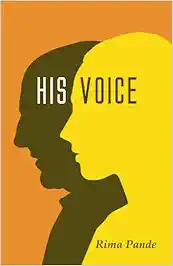12th Book of 2022
Not every time you pick up a book which can take you through several emotions. One such book I completed reading last month is “His Voice” written by Rima Pande and published by The Write Place publishers in around 160-odd pages. This is a daughter’s ode to her father where she speaks in his voice to tell the story of a man who has struggled with physical issues for almost 2 decades out of which last two years has been under paralysis – the situation where he can see and feel things but can’t express himself. Author, Rima Pande, has grabbed this vacuum and tried to give his expression the voice she always could see in his eyes. I understand that just by knowing the theme of this book there must be a lump in your throat – the reason why I started my review with that sentence.
Rima Pande’s writing is very Indian – when I say this – I mean to say that she is completely desi by heart and therefore everything she observes or mentions about her father’s life has a lot of emotions, love, respect, sympathy, empathy, tribute attached to it. You can understand the kind of passion with which she describes everything about what her father is feeling about his deteriorating health, his wishes, his helplessness, his pain to see his caregivers giving their all to keep him well. I could relate very well with her with respect to where she is coming from. The narration is very nicely managed as I thought author would talk only about his disease but the way book takes us through two different timelines- right from the protagonist’s early life to the current scenario keeps the interest alive. I love reading books written in this format.
The story teaches you a lot about gratitude – every page and sentence reflect how it would have been if we were in Agastya’s situation and seen life through his lenses. You start appreciating your health, family and everything you have received in life. Similarly, you start finding positivity everywhere. You understand that there could have been worse than this. You start understanding how life works. It always gives you the best you deserve- it is just about realization which this book makes you recognize and embed in your attitude. Author also pinpoints through her narration about the game of patience. How tough it is to keep waiting for results with a hope that things would get better. Being patient is challenging but eventually, it gives you the path that you need to reach the destination.
It is tough to guess where author is speaking in fictional tone and where she is talking about the real suffering of the character – and that’s the beauty of the book because it makes your imagination create a lot of mind maps and think what if this must have really happened with someone. In Indian culture, family and the bond between its members is one of the most celebrated things which has almost been taken granted these days as the lifestyle has started becoming busy and self-centered. Author’s pen makes you feel love and concern for your parents as well as other family members too. You understand how their presence is subconsciously keeping our mental health in check.
Author says that even if you don't read the book, please call your parents. Don’t wait, don’t hesitate, don’t postpone, don’t judge, just call. Call them today - and listen, for as long as they want to speak to you. And be there when they need you - physically and emotionally. Don’t wait till they need a caregiver. Connect, don’t regret it. This is enough for you to understand the reason behind why author went ahead and took this tough decision of going through the pain and suffering she saw her father go through for years again. This book needs to be read specifically by all the youth below 45 age who end up ignoring parents for career, friends and goals. I give this book 4.25* out of 5. I wish author keep writing to make the readers realize what actually needs to be prioritized in life.
Thanks.
WRITING BUDDHA






.JPG)
